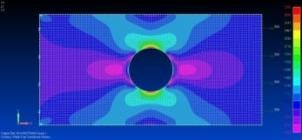FEMAP: Preprocessing

Meshing Control
Refine Models in Femap
In this example of a rectangular plate with a hole, you can see that the overall mesh density of the FE model has to be quite fine to reach a reasonably accurate result. The problem is that a file with that level of detail can become too large.
Femap allows you to control the mesh size and refine the model in areas where you need more accuracy. This provides minimized model sizes without compromising accuracy.
Figure 1

Figure 2

Figure 3

Interactive Meshing
Edit Meshes With Automatic Updates
Creating mesh using a linear workflow can be a headache. If it at any point you have to make edits to the geometry or change the meshing parameters, you have to restart the process.
The interactive workflow in Femap allows you to make edits to the geometry or meshing parameters, and the mesh automatically updates.
Utilizing the Meshing Toolbox
The Meshing Toolbox brings most of the geometry cleanup and meshing functionality in Femap to one powerful pane. Within the toolbox you will find:
- Feature suppression and removal tools to get rid of overly small modeling details.
- Geometry editing tools that combine surfaces and curves to simplify the geometry in preparation for meshing.
- Mesh modification tools to refine the mesh as required.
- A locator to assist in finding problematic geometry.
- Mesh quality visualization controls that can plot mesh quality criteria as you interactively make changes to the mesh.
A typical, linear mesh creation workflow

Femap’s Interactive Workflow

Learn more about the Meshing Toolbox and the individual tools
Interactive Meshing Demonstration
This demonstration will cover:
- Mesh size adjustments prior to meshing
- Meshing of the model and a review of mesh quality
- Further mesh improvements using Femap’s Meshing Toolbox
Accurately Represent Loads and Boundary Conditions
Creating an accurate representation of loading and constraint definitions is a prominent challenge in finite element modeling.
Data Surface Editor
The Femap Data Surface Editor sets up and edits complex spatial load definitions.
A typical use of Data Surfaces is to take the pressure results from a flow analysis in a pipe system and apply them as input loading on a structural model of the pipes to determine the structural response due to the fluid flowing in the pipes.

Data Surface Demonstration
Want to learn more about data surfaces? View the recording of our webinar: Spreading Loads in Femap Using Data Surfaces
Assemblies and Contact
Femap Connection Methods
With the import of an assembly model, Femap offers the ability to automatically determine contact between the assembly components, and beyond that, to easily define the nature of contact – whether it be linear or nonlinear, with or without friction, or glued.
Besides contact and gluing, Femap offers other methods of connecting components of an assembly together including weld, spot weld and fastener elements, and bolted connections which can be pre-loaded.


Edge Glue Contact Demonstration
Nonlinear Constraints
Define Constraints in Femap
More advanced analysis types demand more complex boundary condition definitions.
For example with nonlinear analysis it’s possible to define nonlinear constraints. Similarly with a dynamic response analysis it’s possible to define constraints that are frequency dependent.
Nonlinear Constraints Demonstration
Working with Your Solver
Commercial Solvers and Femap's Additional Modules
Femap can access all major commercial solvers for analysis and results review allowing you to remain in one FE modeling environment.
In addition to the high level of functionality offered in the base module, the Femap product line also offers a great deal of scalability allowing advanced users to access powerful analysis capabilities. The analysis extensions are modular, so you only need to expand as and when you require them – additional modules include:
- Dynamics: one of the main strengths of the Nastran solver
- Design Optimization: that allows sizing optimization of property values to typically minimize the weight of a structure
- Advanced nonlinear: that handles large deformations with highly nonlinear materials in implicit and explicit formulations
- Rotor dynamics: for the analysis of rotating machinery
- Additional advanced Nastran options including superelements, aeroelasticity, and DMAP for Nastran customization
Demonstration: Femap Analysis Manager
The Femap Analysis Manager defines and sets up the analysis, requests data recovery, sets the parameters for the solver, reviews and edits inputs, and submits the analysis.



